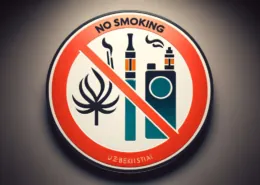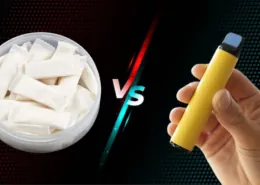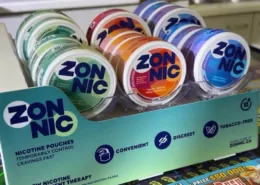What Every Parent Should Know About Nicotine Pouches
As the use of vaping devices among young people began to decline, eliciting a collective sigh of relief from public health officials, a new, potentially worrisome product has gained popularity among youth: nicotine pouches. Unlike cigarettes and vaping devices, which produce smoke and vapor, nicotine pouches are more discreet and harder for parents to notice. Users tuck these pouches between their lip or cheek and gums, allowing the nicotine to be absorbed into their bloodstream through mucous membranes in their mouth.
Nicotine pouches do not contain tobacco, the plant and known carcinogen used in cigarettes and smokeless tobacco, such as chew and dip. However, they do contain nicotine, a chemical found in tobacco. Health experts warn that nicotine has negative effects on everyone, but it is particularly dangerous for young people because it can cause physical changes in their still-developing brains. Nicotine is also a highly addictive stimulant.
The Rise of Nicotine Pouches and Regulatory Challenges
Nicotine pouches were introduced in the United States in 2014. The Food and Drug Administration (FDA) regulates them based on an intention to reduce the toll that using tobacco and nicotine has on public health, rather than the traditional “safe and effective” standard for evaluating medical products.
Due to the relatively new nature of nicotine pouches, the short- and long-term health consequences of using them remain unclear. While some suggest that they may not be as harmful as cigarettes and vaping because they don’t contain tobacco, concerns persist about nicotine’s effects on cardiovascular and oral health.
Nicotine pouches are sold online and in stores to people 21 and older, but they come in various flavors, such as berry, cinnamon, citrus, coffee, and peppermint, which may appeal to youth. ZYN®, the top-selling brand worldwide, has “Zynfluencers” who promote the product on social media channels. Other brands include Rogue, Lucy, Juice Head, VELO, and On!
Uptick in Youth Use and CDC Study Findings
Meghan Morean, PhD, a research scientist at the Yale Tobacco Center of Regulatory Science, notes that while sales of nicotine pouches have risen dramatically in recent years, the uptick in use among youth has not been as considerable as it was for vaping.
A 2023 study from the Centers for Disease Control and Prevention (CDC) found that about 1.5% of middle and high school students reported using nicotine pouches in the last 30 days, compared to 10% who reported using any tobacco product, which includes cigarettes, cigars, e-cigarettes, and nicotine pouches.
What Are Nicotine Pouches?
Nicotine pouches are small rectangles, about the size of a piece of Chiclet® gum, containing nicotine that is either synthetic or derived from tobacco. They come in various flavors and are often sold in tins of 15 to 20 pouches, with varying nicotine strengths. One brand sells tins in either 3 or 6 milligrams of nicotine per pouch, while another brand sells pouches with 13 milligrams of nicotine per pouch.
Users place the pouch between their gum and upper or bottom lip, allowing the nicotine to be absorbed through the inner lining of their cheek and into their bloodstream. Some nicotine can also enter the system by swallowing the juice. When finished, users remove the pouch and dispose of it in the trash.
While nicotine pouches share similarities with nicotine gum, such as Nicorette®, which is used to help people quit smoking, there are key differences. Nicorette contains 2 to 4 milligrams of nicotine and is not available in ultra-appealing flavors to avoid attracting kids. Additionally, Nicorette is an FDA-approved smoking cessation tool, whereas pouches are not.
Also Read:
Nicotine Pouch Ingredients Explained
Potential Dangers of Nicotine Pouches, Especially for Kids
Tobacco use is the leading preventable cause of cancer and cancer deaths. While nicotine may not contain the chemicals and toxins found in cigarette smoke, it is highly addictive and can negatively affect the entire body, causing lung and stomach problems, increasing blood pressure and heart rate, and narrowing arteries, which can lead to a heart attack.
Although nicotine pouches may be a safer alternative to cigarettes or vaping because they don’t contain the known carcinogens associated with tobacco and are not inhaled into the lungs, they are not recommended as something people should pick up, especially not for youth.
Long-term data about the health risks of nicotine pouches are not yet available. Morean points out that while the risk may be minimal, it’s also possible that having varying strengths of nicotine sitting in the mouth in a pouch could have an effect over time. Short-term effects include gum irritation and upset stomach.
Nicotine, being a stimulant, can have detrimental effects on the developing brain in adolescents and young adults, leading to increased impulsivity, ADHD-type cognitive symptoms, and a predisposition to addiction. New nicotine users may also experience a short-lived “buzz” or head rush, which can lead to a cycle of withdrawal and dependence.
Are Nicotine Pouches a Better Alternative to Smoking, Vaping, and Smokeless Tobacco?
For adults who smoke or use smokeless tobacco, nicotine pouches may be a better alternative because they deliver nicotine without tobacco. However, more research is needed to determine the short- and long-term health effects.
Morean emphasizes that while nicotine pouches could be a safer alternative for adults trying to quit, they are not recommended for kids or pregnant women, as nicotine is harmful to fetal development.
What Else Should Parents Know About Nicotine Pouches?
Parents should talk to their children about the risks of nicotine pouches, just as they would with vaping, cigarettes, cannabis, alcohol, and other substances. Although nicotine pouches may not look dangerous as they don’t produce smoke, they are addictive and can harm developing brains.
Adults who use nicotine pouches should keep them out of reach of small children and pets, as the packaging may resemble mints and can be easy to open, despite some claiming to be in child-protective packaging.
- Bestselling Vapes in UK After Disposable Ban: What to Stock 2025 - August 8, 2025
- Argentina Debates Stricter Vape Laws Amid Prohibition Failures - August 8, 2025
- Nigeria Advocacy Group Urged to Hike Tobacco & Vape Tax by 100% - August 8, 2025









